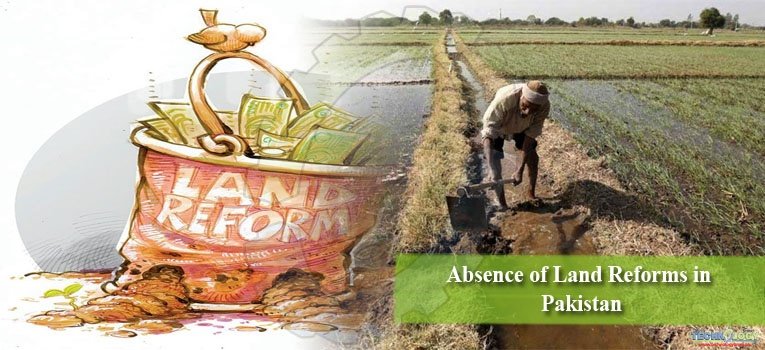Land signifies different things to different segments of society. Whatever use it may be put to, land reforms is, succinctly, a repository of capital, fertile source of wealth, vehicle of getting into the socio-political mainstream, agency of gaining political leverage, instrument of getting let-in into the corridors of power and means to climbing up the higher rungs of the ladder of societal prestige and status.

Besides, it is a hub of agricultural sector and a source of livelihood for millions. Land hosts a varied array of activities. Given the agrarian nature of Pakistani society, not to be hyperbolic, land is the jugular vein of its economy. Land hosts a varied array of activities. Given the agrarian nature of Pakistani society, not to be hyperbolic, land is the jugular vein of its economy.
Land reforms in Pakistan have a long and somewhat cheered history. The British had less of an interest in the matter as they relied on the support of several influential landlords. Although there had been some limited reforms in the years leading up to 1947, all major reforms date from the years after independence.
Almost immediately the various provincial legislatures passed several statutes whereby the jagirdari systems were abolished and tenants protected. The major reforms, however, came in three stages: the first during Ayyub Khan’s martial law in 1959; the second and third during Zulfiqar Ali Bhutto’s rule in the 1970s.
Land reforms in Pakistan traces in 3 waves
The first wave (1959)
Agrarian Reform Committee in 1949, no government was bold enough to adopt the recommendations presented therein. However, upon the installation of the martial law regime in 1958, Ayyub Khan set up a Land Reform Commission on October 31, 1958, to suggest a thorough shake-up of the agricultural setup of the country. The reforms known as “Ayyub Land Reforms” were carried out under the West Pakistan Land Reforms Regulation 1959.
Its salient features included ; 1-None to hold more than 500 acres of irrigated land. 2-The ownership of the un-irrigated land was fixed at 1000 acres.
3-Jagger’s to be abolished without any compensation.
4- Additional land in the form of orchards to be owned up to 150 acres.
Second wave(1972)
The Land Reforms 1972, also called “Bhutto Land Reforms, 1972” constitute the second wave that followed the establishment of Z.A. Bhutto’s democratic government. Regardless of the fact that he himself hailed from an aristocratic background, Bhutto realized the inadequacy of the first wave.
By virtue of a martial law regulation, Pakistan Land Reforms Regulation, 1959, was repealed. The new regime sought to secure these objectives: distribution of land anew, discouragement of absentee landlordism, tenancy reforms and application of latest technologies.
- none to be in excess of 150 acres of irrigated land, or 300 of un-irrigated land, or an area equivalent to 15000 PIU (Produce Index Units).
- Upon owning a tractor, or having installed a tube-well of at least 10 HP, additional land of 3000 PIU to be possessed.
- Land in excess of these limits to be taken without any compensation. The same will be distributed among the tenants.
- Land allocated to the tenants not to exceed the subsistence holding.
Landlords to shoulder the expenses of: land revenue, water charges, seed, cases ,etc
Third wave(1977)
In the last round, Bhutto regime passed another piece of legislation concerned with the land reforms through an elected parliament on January 5, 1977. It did not go on to overturn the 1972 regulations, but was to operate concurrently with the former. Two chief provisions include:
1- It curtailed the individual holding of the irrigated land up to 100 acres, and that of the un-irrigated late up to 200 acres.
2- Agricultural Income Tax to replace the land revenue. The irrigated land of 25 acres or less, and the un-irrigated land of 50 acres or less were exempted from income tax
Ensuring successful implementation of future reforms
- Reliable land records would be required for all individual and joint landowners and their holdings above the “ceiling”. These records should be computerized as has been announced by government several times.
- The ceiling should apply to households to prevent intra-family transfers as in past reforms. Continuing with past reforms, the upper ceiling for the household should be 100 acres for irrigated lands and 200 acres for un-irrigated (barani) lands.
- Only cultivable land should be resumed unlike in past reforms in which almost three-fifths of total resumed land was waste.
- Landowners should be compensated at a reasonable rate for the resumed land; they should be given some cash plus redeemable long-term bonds
- The provincial land commissions should be given the responsibility and resources to resume and redistribute the land. The land revenue departments should be required to coordinate with the land commissions. The judicial process for appeals should not be cumbersome or long to avoid delays in implementation.
- The minimum parcel per family should not be less than 5 acres irrigated and 12 acres unirrigated (barani). These small farms would need to be supported by broader agrarian reforms to ensure the non-reversibility of reforms.